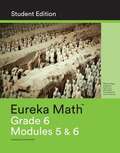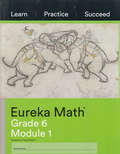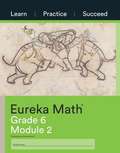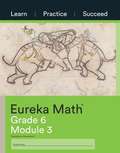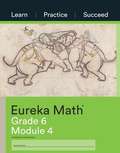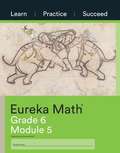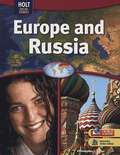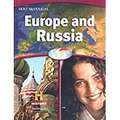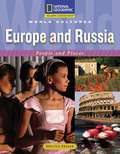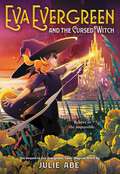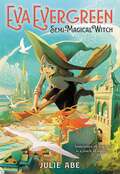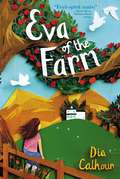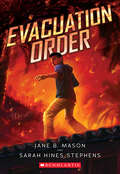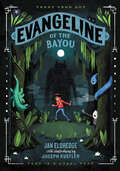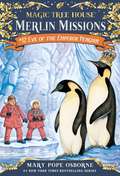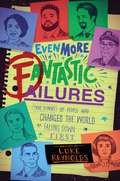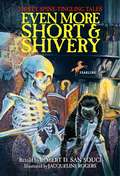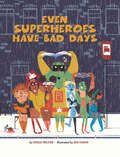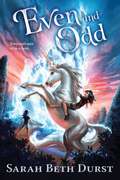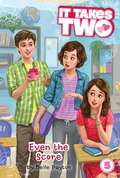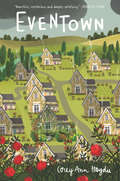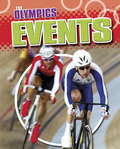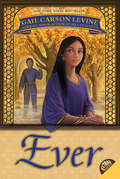- Table View
- List View
Europe and Russia
by Christopher L. SalterThe text covers the history and geography of Europe and Russia. Contains Maps and Resources.
Europe and Russia: People and Places (World Cultures)
by Sherilin ChanekThis book looks at culture in several different ways. As you read about the ways of life of some of Europe and Russia's people, think about how their cultures might compare to your own.
Eva Evergreen and the Cursed Witch (Eva Evergreen #2)
by Julie AbeIn this thrilling sequel to Eva Evergreen, Semi-Magical Witch, Eva must put a stop to the violent Culling or risk the fate of Rivelle Realm forever—perfect for fans of Kiki's Delivery Service.From this day forward, we will believe in the impossible.Eva Evergreen has fulfilled her dream of earning the rank of Novice Witch, and discovered the chilling truth behind the mysterious Culling -- the violent magical storm wreaking havoc across Rivelle Realm.Revealing the truth, however, proves to be a difficult task and soon the culprit is at large. To make matters worse Eva learns what might be the horrible truth behind her pinch of magic and her mother's own mysterious connection to the Culling and rogue magic.With her spirits at an all-time low, Eva must muster up the courage to prove her mother's innocence and learn to believe in her own magic, if she wishes to put a stop to the Culling once and for all.
Eva Evergreen, Semi-Magical Witch (Eva Evergreen #1)
by Julie AbeA young witch must pass a coming-of-age quest or risk losing her magic forever in this enchanting fantasy -- perfect for fans of Kiki's Delivery Service and Aru Shah and the End of Time. <P><P>Sometimes all you need is a pinch of magic... <P><P>Eva Evergreen is determined to earn the rank of Novice Witch before her thirteenth birthday. If she doesn't, she'll lose her magic forever. For most young witches and wizards, it's a simple enough test: <P><P>One: Help your town, do good all around. <P><P>Two: Live there for one moon, don't leave too soon. <P><P>Three: Fly home by broomstick, the easiest of tricks. <P><P>The only problem? Eva only has a pinch of magic. She summons heads of cabbage instead of flowers and gets a sunburn instead of calling down rain. And to add insult to injury, whenever she overuses her magic, she falls asleep. <P>When she lands in the tranquil coastal town of Auteri, the residents expect a powerful witch, not a semi-magical girl. So Eva comes up with a plan: set up a magical repair shop to aid Auteri and prove she's worthy. She may have more blood than magic, but her "semi-magical fixes" repair the lives of the townspeople in ways they never could have imagined. Only, Eva's bit of magic may not be enough when the biggest magical storm in history threatens the town she's grown to love. Eva must conjure up all of the magic, bravery, and cleverness she can muster or Auteri and her dreams of becoming a witch will wash away with the storm.
Eva of the Farm
by Kate Slater Dia CalhounA girl's struggle to save her family's farm, told in verse, stands as a testament to the power of hope.Twelve-year-old Eva DeHart knows her family's farm is the best, most magical place in the whole world. The Farm has apple trees and sun daisies and a creek. The Farm has frightening things too--like cougars, bears, and a dead tree that Eva calls the Demon Snag. And everything at the Farm shoots out of Eva's fingertips into her poems. She dreams of being a heroine of shining deeds, but who ever heard of a heroine-poet? When a blight strikes the orchard and a letter from the bank arrives marked FORECLOSURE, Eva is given that very chance as she puts all the power of her imagination at work to save the Farm. From a booth at the farmer's market to the snowbound hills where the coyotes hunt, Eva discovers that we face our fears and find our courage in the most unexpected places. This novel by acclaimed author Dia Calhoun is about the transforming powers of imagination and hope, which can turn us all into heroes.
Evacuation Order
by Jane B. Mason Sarah Hines StephensIf you only had a few minutes to evacuate your house in the face of a wildfire, what would you take? And if you were separated from your mom and thought she was in danger, would you still leave - or would you head back in to rescue her?Twelve-year-old Sam lives alone with his mom and their dog in the idyllic seaside town of Santa Bonita. His father died when Sam was young, but his best friend Marco has been helping recreate his dad's old photos as part of a memorial project. One particularly warm October day, however, Sam smells something faint from far away. It's the scent of smoke.An unexpected southern California wildfire is whipping ferociously toward town. Sam, Marco, and the whole neighborhood must urgently evacuate with little warning. Sam is distraught. If his house burns, all his memories of his father will go with it.Even worse, Sam’s dog disappears during the emergency, sending the boy into a panic. When he should be leaving the city with Marco and his family, Sam instead turns back, a decision that will plunge him right into the path of a deadly fire.
Evangeline of the Bayou
by Jan EldredgeA spooky, funny middle grade adventure with a sassy, memorable heroine and a charming Southern feel, perfect for fans of Kate DiCamillo, Kate Messner, and Natalie Lloyd.Twelve-year-old haunt huntress apprentice Evangeline Clement spends her days and nights studying the ways of folk magic, honing her monster-hunting skills while pursuing local bayou banshees and Johnny revenants.With her animal familiar sure to make itself known any day now, the only thing left to do is prove to the council she has heart. Then she will finally be declared a true haunt huntress, worthy of following in the footsteps of her long line of female ancestors.But when Evangeline and her grandmother are called to New Orleans to resolve an unusual case, she uncovers a secret that will shake her to the soles of her silver-tipped alligator-skin boots.Set in the evocative Louisiana bayou and the vibrant streets of New Orleans, Evangeline’s is a tale of loyalty and determination, the powerful bonds of friendship and family, and the courage to trust your gut no matter how terrifying that might be.
Eve of the Emperor Penguin (Magic Tree House Merlin Missions #12)
by Mary Pope Osborne Sal MurdoccaJACK AND ANNIE continue their quest for the secrets of happiness--secrets they need to save Merlin. This time, the Magic Tree House takes them to the one continent they haven't visited before: Antarctica! What can they hope to learn about happiness in such a barren place? Only the penguins know for sure . . . Jack and Annie are about to find out! From the Hardcover edition.
Even More Fantastic Failures: True Stories of People Who Changed the World by Falling Down First
by Luke ReynoldsEven the most well-known people have struggled to succeed! This follow-up to Fantastic Failures offers up a second dose of fascinating stories featuring flops that turned into triumphs.Kids today are under a lot of pressure to succeed, but failure has an important place in life as young people learn how to be a successful person. In his teaching career, Luke Reynolds saw the stress and anxiety his students suffered, whether it was over grades, fitting in, or simply getting things right the first time. Even More Fantastic Failures is a second installment in Luke Reynolds&’s personal campaign to show kids it&’s okay to fall down or make mistakes, just so long as you try, try again! Kids will read about a host of inspiring, courageous, and diverse people who have accomplished—or still are accomplishing—big things to make this world a better place. A wide range of stories about Barack Obama, Greta Thunberg, Nick Foles, Emma Gonzalez, Beyoncé, Ryan Coogler, John Cena, Socrates, and even the Jamaican national women&’s soccer team, prove that the greatest mistakes and flops can turn into something amazing. In between these fun profiles, Reynolds features great scientists and other pivotal people whose game-changing discovery started as a failure. Readers will enjoy seeing stories they know highlighted in the new feature &“Off the Page and On the Screen,&” which showcases how failures and successes are presented in books and film. Each profile includes advice to readers on how to come back from their own flops and move forward to succeed.
Even More Short & Shivery: Thirty Spine-Tingling Tales
by Robert D. San Souci Jacqueline RogersThirty spine-chilling stories from around the world provide plenty of shivers in this spooky collection. Curl up with old friends like Washington Irving's "Guests from Gibbet Island" or Charles Dickens' "Chips." Or make the aquaintance of "The Skull That Spoke" and "The Monster of Baylock"--but beware of spectral visitors like "The Blood-Drawing Ghost." This exciting mixture of classic and contemporary tales from Mexico, China, Poland, Nigeria, and other lands near and far is perfect for hair-raising reading!Twenty deliciously eerie illustrations by Jacqueline Rogers highlight this companion to Robert D. San Souci's earlier collections of scary stories, Short & Shivery and More Short & Shivery, which School Library Journal called "an absolute delight."From the Hardcover edition.
Even Superheroes Have Bad Days
by Shelly Becker“Filled with diverse characters, from caped crusaders to badly behaving villains . . . Full of action and vibrancy . . . A good way to soothe bad days away.” —School Library JournalWhen Superheroes don’t get their way,when they’re sad, when they’re mad, when they’ve had a bad day . . .. . . they COULD super-tantrum, they COULD but they DON’T,because REAL Superheroes just WOULDN’T—they WON’T!All kids have trouble getting a grip on their emotions, sometimes—even young superheroes! But what do they do when they’re having a bad day? Colorful action-packed illustrations and a dynamite rhyming text reveal the many ways superheroes (and ordinary children, too) can resist the super-temptation to cause a scene when they’re sad, mad, frustrated, lonely, or afraid. From burning off steam on a bike or a hike, to helping others, this energetic picture book has plenty of fun ideas to help kids cope when they’re feeling overwhelmed.“An action-packed romp.” —Kirkus Reviews“[A] lighthearted exposé on how a group of superheroes deal with their frustrations . . . A spoonful of superheroes certainly helps the message go down.” —Booklist
Even and Odd
by Sarah Beth DurstA half-magic girl learns about heroism and taking action when she and her sister confront a wizard who endangers others for her own gain. Even and Odd are sisters who share magic. Lately, though, it seems like that&’s the only thing they have in common. Odd doesn&’t like magic, and Even practices it every chance she gets, dreaming of the day she&’ll be ready to be a hero. When the hidden border between the mundane world the sisters live in and the magical land they were born in shuts abruptly, the girls are trapped, unable to return home. With the help of a unicorn named Jeremy, they discover a wizard is diverting magic from the border to bolster her own power. Families are cut off from each other on both sides of the border, and an ecological disaster is brewing. But the wizard cares nothing for the calamitous effects her appropriation of magic is having. Someone has to do something to stop her, and Even realizes she can no longer wait until she&’s ready: she needs to be a hero now.
Even the Score (It Takes Two #5)
by Belle PaytonAlex makes an unpopular decision and Ava deals with an unwanted crush in the fifth book of the It Takes Two series!Sporty, shy Ava is finally starting to feel like the guys on the Ashland Middle School football team are accepting her as a player, despite the fact that she’s a girl. But then the star wide receiver, Owen, keeps missing his passes, and his teammates are blaming it on a crush—on Ava! When he awkwardly gives Ava a gift that’s way too expensive, she realizes they’re right. Can she find a way to let Owen down easy and still stay on the team’s good side? Meanwhile, class president Alex has to choose how to spend some student council funds. The football team is scheduled to get a new scoreboard, but the drama department desperately needs new sets and costumes. Alex decides it’s fair to give some money to the arts for a change, but the football fans of Ashland don’t necessarily think so…and it may take a natural disaster for Alex to prove she’s not a football-hater!
Eventown
by Corey Ann HayduAn Amazon Best Book of the Month! “Beautiful, mysterious and deeply satisfying.” —Rebecca Stead, Newbery Medal-winning author of When You Reach Me and Goodbye StrangerThe world tilted for Elodee this year, and now it’s impossible for her to be the same as she was before. Not when her feelings have such a strong grip on her heart. Not when she and her twin sister, Naomi, seem to be drifting apart. So when Elodee’s mom gets a new job in Eventown, moving seems like it might just fix everything.Indeed, life in Eventown is comforting and exciting all at once. Their kitchen comes with a box of recipes for Elodee to try. Everyone takes the scenic way to school or work—past rows of rosebushes and unexpected waterfalls. On blueberry-picking field trips, every berry is perfectly ripe. Sure, there are a few odd rules, and the houses all look exactly alike, but it’s easy enough to explain—until Elodee realizes that there are only three ice cream flavors in Eventown. Ever. And they play only one song in music class. Everything may be “even” in Eventown, but is there a price to pay for perfection—and pretending?
Events (The\olympics Ser.)
by Moira ButterfieldEach title of The Olympics examines the the Olympic Games from ancient times, then the revival of the 1890s through to today's multi-million pound business. From the history of the games to which events are included and why, and from scandals to record breakers, The Olympics puts the reader at the centre of the action with fact-packed text, dramatic full-colour photos, facts and statistics.
Ever
by Gail Carson LevineFalling in love is easy . . . . . . for Kezi, a beautiful mortal, dancer, and rug weaver, and for Olus, Akkan god of the winds. Their love brings Kezi the strength to fight her fate, and it gives Olus the strength to confront his fears. Together—and apart—they encounter spiders with webs of iron, the cruel lord of the land of the dead, the mysterious god of destiny, and the tests of the Akkan gods. If they succeed, they will be together; but if they fail, Olus will have to endure the ultimate loss, and Kezi will have to make the supreme sacrifice. Newbery Honor author Gail Carson Levine has created a stunning world of flawed gods, unbreakable vows, and ancient omens. Her story of love, fate, and belief is spellbinding.
